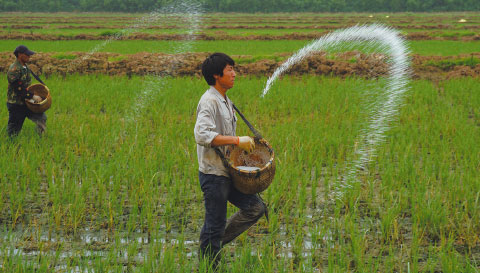Record harvest of summer grains but challenges remain
Insufficient storage, water wastage and fertilizer overuse hamper agricultural efficiency
China's yields of summer grain reached a record high in 2015 after increasing for 11 consecutive years, but challenges remain for the world's most populous country in utilizing this bounty.
The National Bureau of Statistics said recently that the country's summer grain output hit 141.07 million metric tons this year, up 3.3 percent from 2014.
China's summer grain crops, mainly wheat and early-season rice, usually account for about 25 percent of its annual grain output. Autumn grain crops, which include corn and middle - and late-season rice, account for the remaining 75 percent.
"The bumper harvest was a result of the central government's continued support for grain production and full capitalization on science and technology," said NBS senior statistician Hou Rui.
In the context of global grain output reduction and China's economic restructuring, 12 years of bumper harvest have provided a solid foundation for China's food security and sustainable development of agriculture, said Li Guoxiang, a researcher of Chinese Academy of Social Sciences.
But problems remain. The first is an inadequate grain storage capacity.
Harvest season is supposed to be a good time for farmers but not for Tong Qiguo, a 53-year-old farmer from Yichang city of Central China's Hubei province.
He reaped 160,000 kilograms of wheat from his farm of about 27 hectares, but failed to find places to store it, as he had the previous five years.
"Without storage facilities, harvest means nothing," he said.
About 35 million tons of grain are lost or wasted in China every year in the course of storage, transportation and processing.
The country is striving to build more grain-storage facilities and help farmers improve storage conditions. Nevertheless, national grain stocks have hit a new high due to the bumper harvests and increasing imports, said Chen Xiwen, deputy head of the central agricultural work leading team.
Imports of cereals and flour in the first six months of this year jumped 60 percent year-on-year to a record 16.29 million tons, latest customs statistics showed.
Cheap imports
Researcher Li attributed the rise in overall imports to relatively lower global grain prices and diversified demand for grains at home.
Ye Xingqing, head of the agricultural economy department of the Development Research Center under the State Council, said China's raising the minimum purchasing price for grain has made many grain products more expensive here than in many other countries.
As cheaper rice imported from overseas pinches profits, many small and medium-sized grain enterprises are facing difficulties, he said.
China has 9 percent of the world's arable land and 6.5 percent of its fresh water resources, producing a quarter of the world's grain and feeding nearly one-fifth of the world's population.
It's not an easy task. China's arable land is shrinking amid the urbanization drive. It has a "red-line" to guarantee that the amount of land dedicated to arable farming never shrinks to less than 120 million hectares.
Overuse of water and chemical fertilizers is another concern.
Liu Lifang, a farmer from Tanghe county in Henan province, has reduced his chemical fertilizer use after authorities began providing free soil testing for 190 million farmers annually since 2005.
"The experts gave us fertilizer recommendations based on the results," Liu said, adding that the method cuts costs, boosts grain output, improves fertilizer efficiency and reduces pollution.
However, chemical fertilizer use still hit 59 million tons in 2013.
Ye said the key to coping with the challenges lies in promoting new models of agriculture and improving productivity.
Modern agriculture
In Henan province, the Zhonghe Group installed advanced irrigation facilities in a large cropland, which can save 70 percent of electricity, 50 percent of water and 90 percent of labor compared with traditional methods.
"Using it to irrigate a 1,000-mu (67-hectare) field of wheat only needs three farmers to work each hour," said Wang Wenming, a staff member from the company. "That's the power of modern agriculture."
In China, a farmer can plant about 0.5 hectares of cropland on average, while a farmer can plant hundreds of hectares in Europe and even tens of thousands of hectares in the United States with help of agricultural machinery, said Zheng Xinli, deputy director of the China Center for International Economic Exchanges.
The "No 1 Central Document", the first major policy document of each year released by the Central Committee of the Communist Party of China and the State Council, stressed in February that the central government will strive to transform the development mode of agriculture and boost policies that benefit farmers.
In the long run, the goal of modern agriculture development lies in high efficiency, product safety, resource saving and environment friendliness, said Qin Fu, a researcher at the Chinese Academy of Agricultural Sciences.
|
Farmers in Jiangsu province fertilize rice paddies to ensure a good harvest. The efficient use of fertilizers is key to achieving better output.Geng Yuhe / For China Daily |
(China Daily 07/31/2015 page22)















